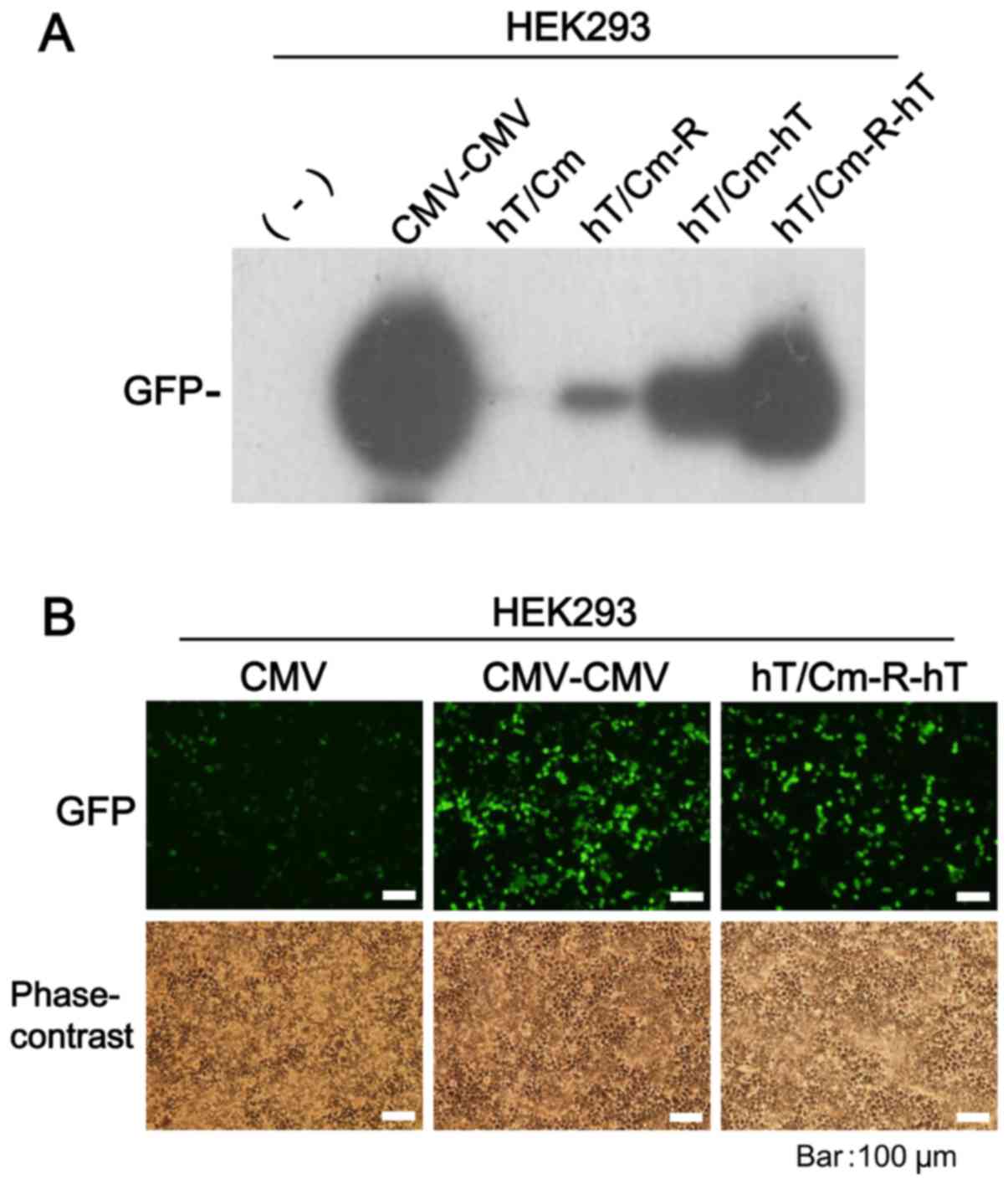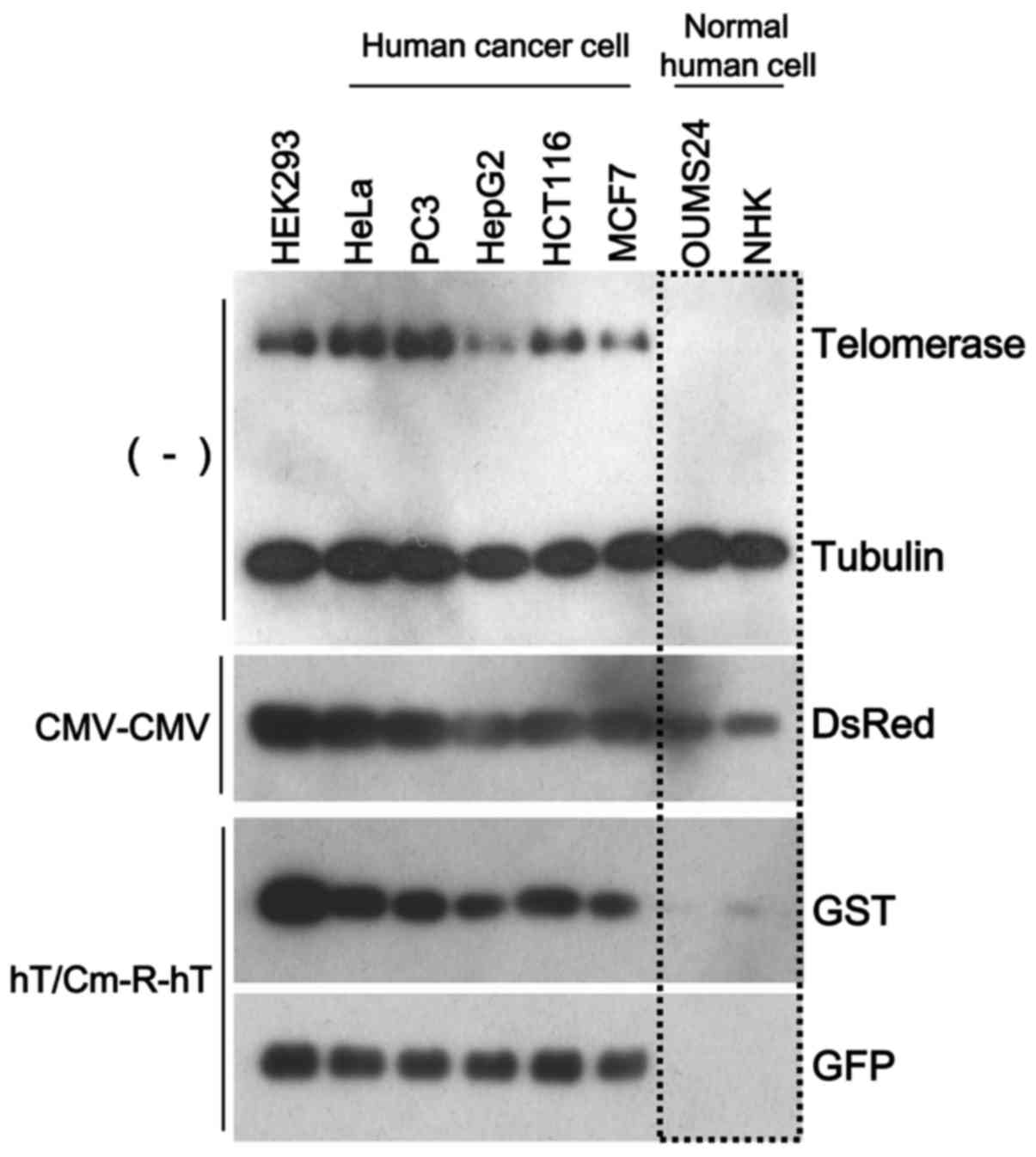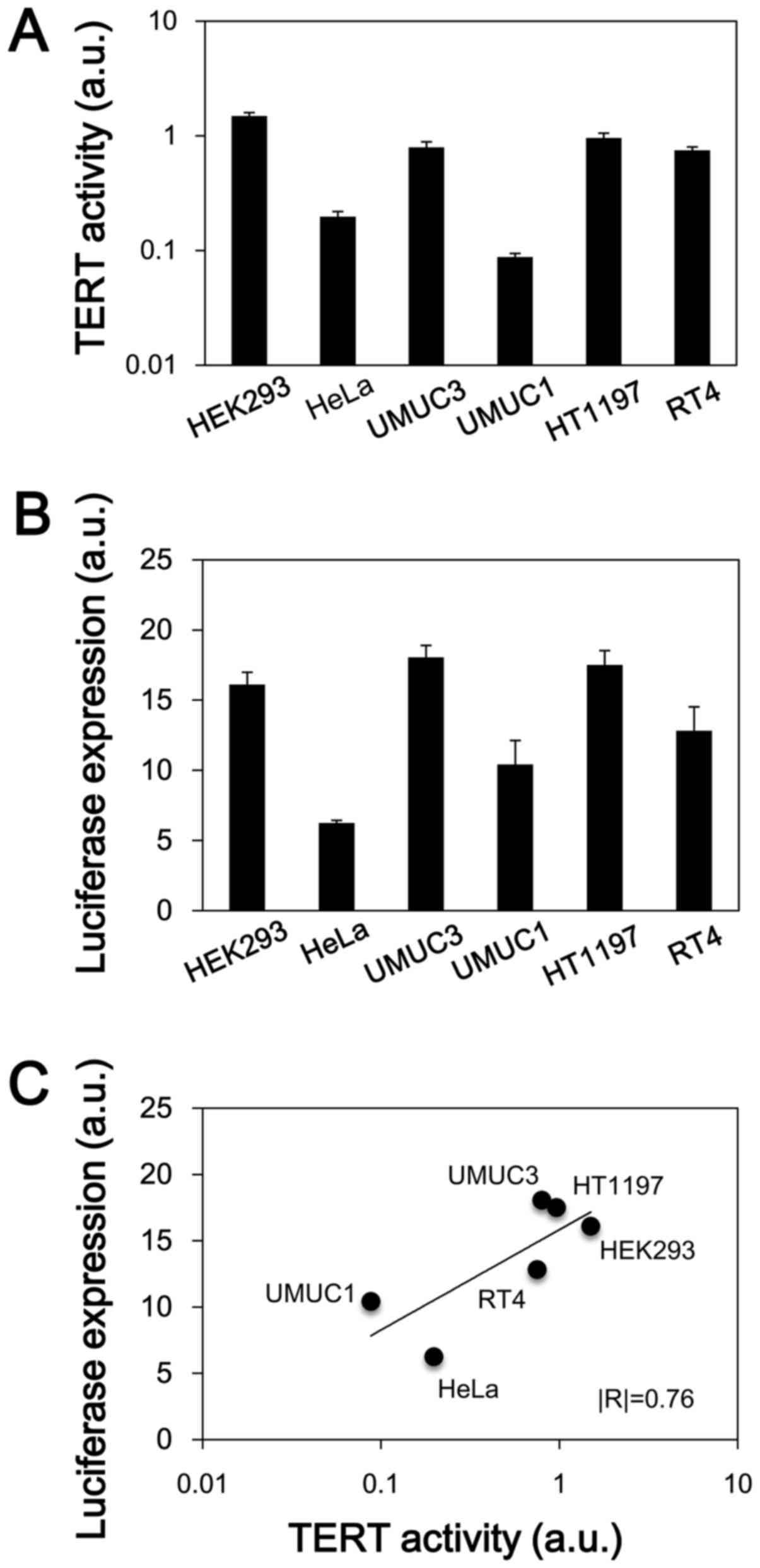|
1
|
Greider CW: Telomere length regulation.
Annu Rev Biochem. 65:337–365. 1996. View Article : Google Scholar : PubMed/NCBI
|
|
2
|
Greider CW: Chromosome first aid. Cell.
67:645–647. 1991. View Article : Google Scholar : PubMed/NCBI
|
|
3
|
Nakamura TM and Cech TR: Reversing time:
Origin of telomerase. Cell. 92:587–590. 1998. View Article : Google Scholar : PubMed/NCBI
|
|
4
|
Tahara H, Yasui W, Tahara E, Fujimoto J,
Ito K, Tamai K, Nakayama J, Ishikawa F, Tahara E and Ide T:
Immuno-histochemical detection of human telomerase catalytic
component, hTERT, in human colorectal tumor and non-tumor tissue
sections. Oncogene. 18:1561–1567. 1999. View Article : Google Scholar : PubMed/NCBI
|
|
5
|
Kim NW, Piatyszek MA, Prowse KR, Harley
CB, West MD, Ho PL, Coviello GM, Wright WE, Weinrich SL and Shay
JW: Specific association of human telomerase activity with immortal
cells and cancer. Science. 266:2011–2015. 1994. View Article : Google Scholar : PubMed/NCBI
|
|
6
|
Takakura M, Kyo S, Kanaya T, Hirano H,
Takeda J, Yutsudo M and Inoue M: Cloning of human telomerase
catalytic subunit (hTERT) gene promoter and identification of
proximal core promoter sequences essential for transcriptional
activation in immortalized and cancer cells. Cancer Res.
59:551–557. 1999.PubMed/NCBI
|
|
7
|
Kishimoto H, Kojima T, Watanabe Y, Kagawa
S, Fujiwara T, Uno F, Teraishi F, Kyo S, Mizuguchi H, Hashimoto Y,
et al: In vivo imaging of lymph node metastasis with
telomerase-specific replication-selective adenovirus. Nat Med.
12:1213–1219. 2006. View
Article : Google Scholar : PubMed/NCBI
|
|
8
|
Maida Y, Kyo S, Sakaguchi J, Mizumoto Y,
Hashimoto M, Mori N, Ikoma T, Nakamura M, Takakura M, Urata Y, et
al: Diagnostic potential and limitation of imaging cancer cells in
cytological samples using telomerase-specific replicative
adenovirus. Int J Oncol. 34:1549–1556. 2009.PubMed/NCBI
|
|
9
|
Cong YS, Wen J and Bacchetti S: The human
telomerase catalytic subunit hTERT: Organization of the gene and
characterization of the promoter. Hum Mol Genet. 8:137–142. 1999.
View Article : Google Scholar : PubMed/NCBI
|
|
10
|
Huang P, Kaku H, Chen J, Kashiwakura Y,
Saika T, Nasu Y, Urata Y, Fujiwara T, Watanabe M and Kumon H:
Potent antitumor effects of combined therapy with a
telomerase-specific, replication-competent adenovirus (OBP-301) and
IL-2 in a mouse model of renal cell carcinoma. Cancer Gene Ther.
17:484–491. 2010. View Article : Google Scholar : PubMed/NCBI
|
|
11
|
Kojima T, Hashimoto Y, Watanabe Y, Kagawa
S, Uno F, Kuroda S, Tazawa H, Kyo S, Mizuguchi H, Urata Y, et al: A
simple biological imaging system for detecting viable human
circulating tumor cells. J Clin Invest. 119:3172–3181. 2009.
View Article : Google Scholar : PubMed/NCBI
|
|
12
|
Iyer M, Wu L, Carey M, Wang Y, Smallwood A
and Gambhir SS: Two-step transcriptional amplification as a method
for imaging reporter gene expression using weak promoters. Proc
Natl Acad Sci USA. 98:14595–14600. 2001. View Article : Google Scholar : PubMed/NCBI
|
|
13
|
Watanabe M, Ueki H, Ochiai K, Huang P,
Kobayashi Y, Nasu Y, Sasaki K, Kaku H, Kashiwakura Y and Kumon H:
Advanced two-step transcriptional amplification as a novel method
for cancer-specific gene expression and imaging. Oncol Rep.
26:769–775. 2011.PubMed/NCBI
|
|
14
|
Ueki H, Watanabe M, Kaku H, Huang P, Li
SA, Ochiai K, Hirata T, Noguchi H, Yamada H, Takei K, et al: A
novel gene expression system for detecting viable bladder cancer
cells. Int J Oncol. 41:135–140. 2012.PubMed/NCBI
|
|
15
|
Watanabe M, Sakaguchi M, Kinoshita R, Kaku
H, Ariyoshi Y, Ueki H, Tanimoto R, Ebara S, Ochiai K, Futami J, et
al: A novel gene expression system strongly enhances the anticancer
effects of a REIC/Dkk-3-encoding adenoviral vector. Oncol Rep.
31:1089–1095. 2014.PubMed/NCBI
|
|
16
|
Agha-Mohammadi S, O'Malley M, Etemad A,
Wang Z, Xiao X and Lotze MT: Second-generation
tetracycline-regulatable promoter: Repositioned tet operator
elements optimize transactivator synergy while shorter minimal
promoter offers tight basal leakiness. J Gene Med. 6:817–828. 2004.
View Article : Google Scholar : PubMed/NCBI
|
|
17
|
Senju S, Haruta M, Matsumura K, Matsunaga
Y, Fukushima S, Ikeda T, Takamatsu K, Irie A and Nishimura Y:
Generation of dendritic cells and macrophages from human induced
pluripotent stem cells aiming at cell therapy. Gene Ther.
18:874–883. 2011. View Article : Google Scholar : PubMed/NCBI
|
|
18
|
Sakaguchi M, Watanabe M, Kinoshita R, Kaku
H, Ueki H, Futami J, Murata H, Inoue Y, Li SA, Huang P, et al:
Dramatic increase in expression of a transgene by insertion of
promoters downstream of the cargo gene. Mol Biotechnol. 56:621–630.
2014. View Article : Google Scholar : PubMed/NCBI
|
|
19
|
Huang J, Wang F, Okuka M, Liu N, Ji G, Ye
X, Zuo B, Li M, Liang P, Ge WW, et al: Association of telomere
length with authentic pluripotency of ES/iPS cells. Cell Res.
21:779–792. 2011. View Article : Google Scholar : PubMed/NCBI
|




















